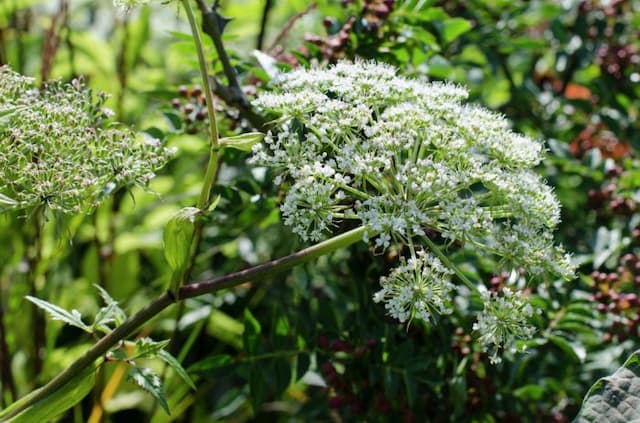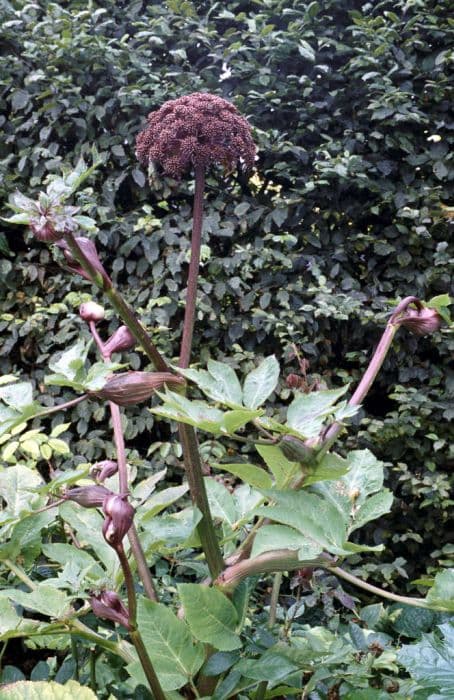Bishop's Flower Ammi majus 'Graceland'

ABOUT
Ammi majus 'Graceland', commonly known as Queen Anne's lace, bears a striking resemblance to wild carrot. This plant is characterized by delicate, lacy white flowers that are clustered into broad, flat-topped umbels. The blossoms offer a frothy, ethereal quality that can soften the appearance of a garden. These flowers appear atop long, slender, and hollow green stems that have a graceful and airy nature. The foliage of Queen Anne's lace is finely cut and fern-like, adding to the plant's overall feathery texture. The light green leaves are arranged in a feathery pattern and are soft to the touch. When it comes to the root system, it is typically taprooted, much like the roots of a true carrot. The wispy and elegant blooms are a favorite for adding texture to bouquets and floral arrangements. In full bloom, Queen Anne's lace offers a cottage garden feel and attracts a variety of pollinators, including bees and butterflies, which adds to its charm and ecological benefits as a plant in the garden landscape.
About this plant
 Names
NamesFamily
Apiaceae
Synonyms
Bishop's Weed, Queen Anne's Lace, False Queen Anne's Lace, Bullwort, Greater Ammi, Laceflower
Common names
Ammi majus 'Graceland'.
 Toxicity
ToxicityTo humans
The plant commonly known as Bishop's weed (Ammi majus 'Graceland') is not typically considered highly toxic to humans, but it does contain furanocoumarins which can cause photodermatitis, a skin reaction to sunlight. If the plant sap gets on the skin and the skin is then exposed to sunlight, it can cause blistering or rashes. Ingesting large amounts of the plant may lead to gastrointestinal discomfort such as nausea, vomiting, or diarrhea. It is not usually considered life-threatening but could pose health risks, especially when consumed in significant quantities or by individuals with certain health vulnerabilities.
To pets
Bishop's weed (Ammi majus 'Graceland') can be toxic to pets, particularly if they consume a large amount of the plant. The primary concern with its toxicity is the presence of furanocoumarins, which can cause photodermatitis in animals similar to humans. This can occur if the pet gets plant sap on their skin followed by exposure to sunlight, leading to skin irritation or rashes. Additionally, if a pet ingests a significant amount of Bishop's weed, they may experience symptoms such as drooling, vomiting, and diarrhea. While poisoning from this plant is generally not life-threatening, pet owners should still exercise caution to prevent pets from ingesting it and seek veterinary care if they suspect poisoning.
 Characteristics
CharacteristicsLife cycle
Annuals
Foliage type
Deciduous
Color of leaves
Green
Flower color
White
Height
3 feet [0.91 meters]
Spread
1 foot [0.30 meters]
Plant type
Herb
Hardiness zones
7
Native area
Mediterranean
Benefits
 General Benefits
General Benefits- Attracts pollinators: Ammi majus 'Graceland', commonly known as Bishop's flower, attracts beneficial insects such as bees and butterflies to the garden.
- Ornamental value: It features delicate white flowers that add an airy, lace-like appearance to garden landscapes and floral arrangements.
- Drought tolerance: Bishop's flower exhibits a degree of drought resistance, making it suitable for gardens in dryer climates or for low-water gardening practices.
- Wildlife habitat: The plant provides a habitat for various insects, serving as a valuable part of a healthy ecosystem.
- Easy to grow: Ammi majus 'Graceland' is known for its ease of cultivation, requiring minimal maintenance once established.
- Self-seeding: It can self-propagate through seed dispersal, potentially reducing the need for replanting each year.
- Supports biodiversity: By attracting a wide range of insects, it helps to support local biodiversity.
 Medical Properties
Medical PropertiesThis plant is not used for medical purposes.
 Air-purifying Qualities
Air-purifying QualitiesThis plant is not specifically known for air purifying qualities.
 Other Uses
Other Uses- Photography Prop: Ammi majus 'Graceland', also known as Queen Anne's lace, is often used by photographers as a delicate and airy element to enhance natural-themed photo shoots.
- Educational Tool: Botany teachers may use Queen Anne's lace to demonstrate aspects of Apiaceae family characteristics to students.
- Eco-Friendly Confetti: The small, white flowers of Queen Anne's lace can be dried and used as natural, biodegradable confetti for events such as weddings.
- Dye: The flowers and seeds of Queen Anne's lace can be used to produce a yellow dye for coloring fabrics and yarns.
- Garden Habitat: Queen Anne's lace can be planted to create a habitat that supports beneficial insects like ladybugs and lacewings which help control garden pests.
- Companion Planting: It's sometimes used in companion planting to attract predatory insects that feed on garden pests like aphids and mites.
- Floral Arranging Courses: Ammi majus 'Graceland' is used in floral design classes to teach students about the use of filler flowers in arrangements.
- Decorative Potpourri: The dried flowers and foliage can be added to potpourri mixes for a natural, rustic look and a subtle, pleasant scent.
- Illustration Subject: Due to its intricate structure, Queen Anne's lace is a popular subject for botanical illustrators and natural science artists.
- Culinary Garnish: Although not common, the flowers can be used as an ornamental garnish for dishes in upscale dining settings.
Interesting Facts
 Feng Shui
Feng ShuiThe Bishop's Flower is not used in Feng Shui practice.
 Zodiac Sign Compitability
Zodiac Sign CompitabilityThe Bishop's Flower is not used in astrology practice.
 Plant Symbolism
Plant Symbolism- Innocence: Ammi majus, commonly known as Bishop's flower, often symbolizes innocence due to its delicate and pure white flowers that evoke a sense of childlike wonder and simplicity.
- Purity: The white color of the Bishop's flower is traditionally associated with purity and virtue, making it a popular choice for weddings and christenings where these qualities are esteemed.
- Sanctity: Named after high-ranking church officials, the Bishop's flower carries a connotation of holiness and spiritual reverence, often used in religious ceremonies to signify sanctity.
- Connection with Nature: Its wildflower appearance and preference for natural environments make the Bishop's flower an emblem of the deep connection between humans and nature.
- Healing: Historically, the Bishop's flower has been used in folk medicine, which gives it a symbolic meaning of healing and restorative properties.
 Water
WaterThe Laceflower, commonly known as Bishop's Flower, should be watered regularly but allowed to dry out slightly between waterings to avoid waterlogging. Typically, during the growing season, it may require watering approximately once a week with about 1 gallon of water, depending on the climate and soil moisture. In hot and dry conditions, you may need to water more frequently, whereas in cooler or rainy periods, you can reduce the watering frequency. It's important to ensure the plant is in well-draining soil to prevent root rot.
 Light
LightBishop's Flower thrives in full sun environments where it can receive at least 6 to 8 hours of direct sunlight daily. The ideal spot for this plant is a location without any shade during peak sunlight hours, as it needs abundant light to develop fully and produce its characteristic delicate blooms.
 Temperature
TemperatureBishop's Flower prefers moderate temperatures and is hardy in USDA zones 3 through 9. It can survive minimum temperatures down to around -40 degrees Fahrenheit but will flourish in temperatures between 60 to 65°F. Maximum temperature tolerance is generally around 85°F, but it can endure short periods of higher temperatures as long as it is well-watered.
 Pruning
PruningBishop's Flower benefits from pruning to encourage bushier growth and more abundant flowering. Prune or deadhead spent flowers regularly to promote continuous blooms and prevent self-sowing if not desired. The best time for heavy pruning is in late winter or early spring before new growth begins.
 Cleaning
CleaningAs needed
 Soil
SoilBishop's flower thrives in well-draining soil with a neutral to slightly alkaline pH, ideally around 7.0 to 7.5. A mix of loamy garden soil, compost, and a portion of sand or perlite to enhance drainage creates the best soil environment for its growth.
 Repotting
RepottingBishop's flower, being an annual, does not typically require repotting. Instead, they are sown directly where they are to flower, as they do not transplant well.
 Humidity & Misting
Humidity & MistingBishop's flower prefers moderate humidity levels but is quite adaptable and can tolerate a range of humidity conditions as long as the soil moisture is appropriate and well-regulated.
 Suitable locations
Suitable locationsIndoor
Place in bright light, sow annualy, maintain moist soil.
Outdoor
Sow directly, sunny spot, water regularly.
Hardiness zone
7-10 USDA
 Life cycle
Life cycleAmmi majus 'Graceland', commonly known as Queen Anne's Lace or Bishop's Flower, begins its life cycle as a seed, which requires a period of cold stratification to germinate effectively. Upon germination, the seedling gradually develops a basal rosette of feathery, green foliage during its first growing season. As a biennial, it enters a period of dormancy during the winter and resumes growth in its second growing season. In the second year, the stalk elongates and the plant produces tall, branching stems topped with delicate, lacy white flower umbels which attract a diverse range of pollinators. After flowering, usually from mid-summer to early fall, the plant sets seed and the flowers transform into dry, schizocarpic fruit that split into mericarps when mature. The plant completes its life cycle by dying after seed dispersal, with the seeds lying dormant until the conditions are favorable for the cycle to start anew.
 Propogation
PropogationPropogation time
Spring to Summer
The Ammi majus 'Graceland', commonly known as Queen Anne's lace, is typically propagated by seeds. The best time to sow the seeds is either in the early spring as the soil begins to warm or in the late fall before the ground freezes, taking advantage of the natural stratification process which helps break seed dormancy. To propagate this plant, scatter the tiny seeds directly onto a well-drained soil surface where you wish for the plants to grow, as they do not transplant well due to their long taproot. Gently press the seeds into the soil to ensure good seed-to-soil contact but do not cover them with soil because they need light to germinate. Make sure you keep the soil moist until germination, which should occur within 7-14 days in the right conditions. Once the seedlings emerge and grow strong enough, thin them to stand about 6 to 9 inches (15 to 23 centimeters) apart to allow for ample growth.









